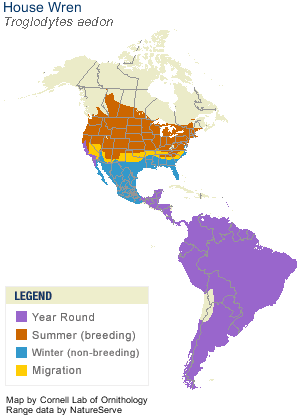Appearance:

Retrieved from: http://www.allaboutbirds.org/guide/PHOTO/LARGE/h ouwre_235536_Spr09.jpg
From a distance, the House Wren appears to be a uniform brownish gray. The head, nape, and back are a uniform shade of brown; the chest and throat are a uniform light gray, sometimes with buffy or brownish tinge. The eyebrow has a distinctive white stripe, and the tail, wings, and flank (between the ribs and the hip) have some black and dark brown marks. The plumage is identical between the sexes and no seasonal changes with the male slightly larger than the female in some traits. (Scott 2014). The small and compact figure with a flat head and long, curved beak helps identify the House Wren.
Social Behavior:

Retrieved from: http://stlucieaudubon.org/hartBeat/Images/2012/120603CarolinaWrenBabies.jpg
House wrens are territorial and are usually alone except during breeding season and on a wintering ground. During breeding season, House Wrens are found in pairs or in immediate family groups while when on a wintering ground, they are rarely found with a flock and usually found alone (Scott 2014). However, House Wrens can be seen acting kindly. There is a case of a male House Wren that fed a nestling Northern Flickers in a nest above his own. After his offsprings hatched, he fed both the nestling Northern Flickers and his own offsprings (Royall and Pillmore 1968). On the other hand, House Wrens can be seen acting aggressively. In another case, the House Wrens pecked and removed eggs of all species 1-3m around their nest and destroyed quail eggs in an open nest 20-40m from their own nest (Belles-Isles and Picman 1986). Interestingly, the males attacked eggs only before pairing and females only before laying (Kennedy and White 1996). Moreover, the presence of a small wasp nests in a cavity does not deter nesting but rather the wrens become aggressive, killing the wasps and knocking the nests if it is an obstacle (McAtee1927).
Breeding Behavior:

Retrieved from: http://bna.birds.cornell.edu/bna/species/380 /galleries/photos/WFVZ_N_HouseWren/im age_popup_view
The length of House Wren’s breeding season varies on the elevation. In California, the first eggs appear in April and at many low-elevation sites (Purcell et al. 1997) compared to Illinois where the first eggs appear around the beginning of May (Drilling and Thompson 1991). The House Wren arrives individually on the breeding grounds and not in pairs. The females arrive first in mid to late April or early May then within a few days the first males arrive. Females choose mates within a few days of arrival. On the other hand, males continue to settle on territories and obtain mates many weeks into the season (Kendeigh 1941:14). It is uncertain whether the late-settling individuals are late migrants or birds entering the area after failed attempts elsewhere. However, if the late-settling individual is a bird that is entering after a failed attempt elsewhere, is his chance of finding a mate greater?

Retrieved from: http://bna.birds.cornell.edu/bna/species/380/galleri es/photos/HOWR_Johnson_3/image_popup_view
To address this, an experiment to help determine if a bird has a greater chance after a failed attempt elsewhere would be to have a House Wren that failed his mating attempt and a control House Wren and calculate the successes of mating attempts. Sometimes the male will have more than one mating partner. When this happens, he either remains on the same territory or establishes a new territory elsewhere. In either cases, the male deserts the female and usually the deserted female will not breed again. Moreover, when the female deserts the male, the deserted male is less likely to breed. When the male establishes or claims a new territory, he immediately begins building a nest that the female helps complete when she pairs with him (Scott 2014).
Habitat:

Retrieved from: http://www.allaboutbirds.org/guide/PHOTO/LARGE/trog_a edo_AllAm_map.gif
The House Wren has a huge geographic range and lives in so many different habitats as long as they feature trees, scrubs, and tangles interspersed with clearings. The habitats can range from deciduous forests and swamps to conifer forests and aspen groves. House Wrens thrive in places like backyards, farmyards, and city parks. In the winter, they prefer other areas in brushy tangles, thickets, and hedgerows. House Wrens often forge in low tree branches and shrubs and occasionally flit across openings with steady, level flight, or investigating the ground with quick hops (All About Birds). The preys that the House Wren captures vary from cicadas and caterpillars to millipedes and bees. The most common diet in the adults were Hemiptera (cicadas, leafhoppers, etc), while the most common food items in the nestlings’ diet were grasshoppers and crickets (Scott 2014).
Foraging:

Retrieved from: http://bna.birds.cornell.edu/bna/species/380/galleries/photos /HOWR_Rendell_3/image_popup_view
The preys that the House Wren captures vary from cicadas and caterpillars to millipedes and bees. The most common diet in the adults were Hemiptera (cicadas, leafhoppers, etc), while the common diet in the nestlings were grasshoppers and especially crickets (Scott 2014).
Citations:
All About Birds. The Cornell Lab of Ornithology. Web. 5 Apr. 2015. http://www.allaboutbirds.org/guide/House_Wren/id
Belles-Isles, J. C. and Picman, J. 1986. House Wren nest-destroying behavior. Condor 88:190-193.
Drilling, N. E. and Thompson, C.F. 1991. Mate switching in multibrooded House Wrens. Auk 108:60-70.
Johnson, L. Scott. 2014. House Wren (Troglodytes aedon), The Birds of North America Online (A. Poole, Ed.). Ithaca: Cornell Lab of Ornithology; Retrieved from the Birds of North America Online :http://bna.birds.cornell.edu/bna/species/380
Kendeigh, S. C. 1941. Territorial and mating behavior of the House Wren.Illinois Biol. Monogr. 18:1-120.
Kennedy, E. D. and White, D.W.. 1996. Interference competition from House Wrens as a factor in the decline of Bewick’s Wrens. Conserv. Biol. 10:281-284.
McAtee, W. L. 1927. Notes on insect inhabitants of bird houses. Proceedings of the Entomological Society of Washington. 29:87-90.
Purcell, K. L., Verner, J., and Oring, L. W. 1997. A comparison of the breeding ecologies of four bird species nesting in boxes and tree cavities.Auk 114:646-656.
Royall, Jr., W. C. and Pillmore, R. E. 1968. House Wren feeds Red-Shafted Flicker nestlings. Murrelet 49:4-6.
